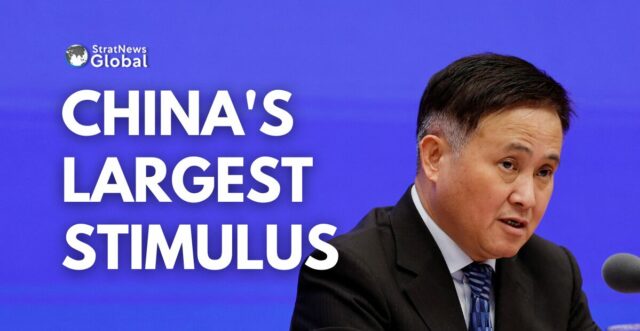On Tuesday, China’s central bank, the People’s Bank of China (PBOC), introduced its most substantial economic stimulus package since the pandemic. The aim is to counter deflationary pressures and boost the economy towards the government’s growth target of 5% for the year. However, analysts cautioned that without additional fiscal measures, the package alone might not be sufficient to meet these ambitious goals.
Broader-Than-Expected Measures
The PBOC’s latest move includes increased funding, interest rate cuts, and efforts to ease mortgage repayment burdens. Governor Pan Gongsheng announced plans to lower borrowing costs, inject liquidity, and reduce banks’ reserve requirement ratios (RRR) by 50 basis points, releasing about 1 trillion yuan ($142 billion) for new lending. There’s also potential for a further 0.25-0.5 percentage point RRR cut, depending on liquidity needs later this year.
While these steps represent the most significant PBOC action since early 2020, some experts argue it may not be enough to reignite strong growth. Julian Evans-Pritchard of Capital Economics remarked, “This is the most significant PBOC stimulus package since the early days of the pandemic,” but added that more fiscal stimulus may be necessary.
Boost to Financial Markets
In response to the announcement, Chinese stocks and bonds rallied, and Asian markets hit 2-1/2 year highs. The yuan surged to a 16-month high against the US dollar as expectations grew for lower borrowing costs.
While Pan did not specify when these new measures will take effect, analysts noted that the rate cuts and liquidity injections were overdue. Gary Ng, senior economist at Natixis, remarked, “The move probably comes a bit too late, but it is better late than never. China needs a lower-rate environment to boost confidence.”
Property Crisis and Market Support
A key part of the stimulus package addresses China’s struggling property sector, which has been in severe decline since peaking in 2021. The PBOC announced a 50 basis point reduction in interest rates for existing mortgages and lowered the minimum downpayment requirement to 15% for all home purchases.
Despite these efforts, China’s real estate market remains in crisis, with housing prices falling at their sharpest pace in over nine years as of August. Homebuilders face mounting debt, and many development projects remain unfinished. Given that 70% of household savings are tied to real estate, the property crisis has dampened consumer confidence. Analysts from Gavekal Dragonomics expressed doubt about the effectiveness of the latest measures, noting that uncertain income prospects in a weak job market may discourage households from taking on more debt.
New Tools for Capital Market Support
To further stabilize the financial market, the PBOC introduced two new measures. The first is a 500 billion yuan swap program, providing insurers, brokers, and funds easier access to capital for stock purchases. The second offers up to 300 billion yuan in cheap loans to banks, enabling them to finance stock buybacks and share purchases by other entities.
Call for More Fiscal Stimulus
While these monetary moves are significant, analysts agree that China’s economy may require more robust fiscal interventions. August economic data underperformed expectations, heightening the urgency for further action. Local governments have ramped up bond issuance to fund infrastructure projects, but many believe that more aggressive fiscal policies are needed.
ANZ analysts noted that “an aggressive fiscal policy is required to inject genuine economic demand,” describing the PBOC’s current measures as “far from being a bazooka.” Several investment banks, including Goldman Sachs and UBS, have already lowered their growth forecasts for China in 2024.
Despite these challenges, ING economist Lynn Song indicated that there is “still room for further easing in the months ahead” and suggested that a larger fiscal push could improve momentum by the fourth quarter.
(With Inputs from Reuters)
Research Associate at StratNewsGlobal, A keen observer of #China and Foreign Affairs. Writer, Weibo Trends, Analyst.
Twitter: @resham_sng





